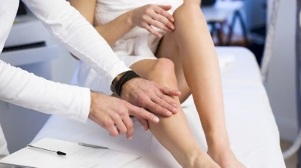Varicose veins are referred to a disease that quickly becomes chronic. The disease causes changes in the length and diameter of the veins, the appearance of varicose veins, thinning of the venous wall. Often, varicose veins are manifested during pregnancy, when a woman’s body has a lot of burden against the background of hormonal changes.
Cause of appearance

If we consider the causes under the influence of varicose veins occur during pregnancy, we can distinguish several main causes:
- Weight change.During pregnancy, veins arise in the legs due to weight gain of ten or more kilograms, which causes an increase in pressure and load on the vessels;
- Hormonal changes in the body.During fetal formation, the female hormonal background is repeatedly rebuilt, which damages the ducts - they lose elasticity, become brittle, susceptible to the appearance of varicose veins;
During pregnancy, veins arise in the legs due to weight gain of ten or more kilograms.
- During pregnancy, the work of the venous valves changes, as the amount of circulating blood increases. It should be noted that varicose veins after pregnancy, if left untreated, do not disappear anywhere;
- Hereditary factors. If one of the parents of a pregnant woman is sick with varicose veins, the chances of her having the same disease are high;
- Choosing the wrong clothes and shoes. Sometimes pregnant mothers are shocked by where the varicose veins come from, without thinking that tights and high-heeled shoes can provoke;
- Decreased physical activity. In the leg veins during pregnancy, blood stasis can start if the pregnant woman moves a little and does not do special exercises.
Some reasons why varicose veins during pregnancy are easily eliminated - change your habits.
Symptoms and Signs
Varicose veins during early pregnancy are difficult to detect, as there are no obvious symptoms.

However, it is a good idea to contact your doctor if there are any of the following symptoms:
- heaviness and pain in the legs;
- swelling, especially in the evening, if you sit for a long time;
- seizures, especially at night;
- redness or darkening of the skin;
- emergence of vascular network;
- sealing on the skin, the appearance of trophic ulcers;
- Inflammatory veins during pregnancy are easily touched.
Types of varicose veins during pregnancy
Varicose veins during pregnancy can be of several types. The most common diseases are:
- in the groin;
- on foot;
- in vagina;
- in the womb.
Manifestations of varicose veins in the small pelvis have symptoms similar to some gynecological diseases, so it is most difficult to diagnose. With each pregnancy, the risk of varicose veins on the labia also increases (symptoms most felt after physical exercise or sexual intercourse).
Diagnostics
Varicose veins and pregnancy have a huge impact on a woman's body, causing additional stress on many organs, so it is important to identify the disease at an early stage.
To identify varicose veins in pregnant women, the duplex sonography method is used today. This type of modern diagnostics has replaced ultrasound angioscanning mapping and Doppler mapping previously performed. Duplex sonography is performed in twenty minutes and provides detailed information on the condition of deep and superficial veins.
In some cases, for additional diagnostic purposes, do:
- Doppler Segment.A simple but reliable test that shows the condition of the artery, proving its courage and narrowing.
- BMR (magnetic resonance venography).If varicose veins are diagnosed during pregnancy, this examination allows you to assess the condition of the vessel without using contrast, it does not pose a danger to the body.
- Calculated computed tomography.Performed with the use of contrast, it is possible to assess the condition of blood vessels at great depth. If varicose veins have vague symptoms, this type of examination is prescribed.

Disease treatment methods
Not all methods that can be used to treat varicose veins after pregnancy can be used during pregnancy. For example, during pregnancy, injections of certain drugs may not be used; surgery is not always possible. This restriction also applies to women with varicose veins in the legs, but plans to become pregnant in the next two years.
Surgical treatment
As mentioned earlier, varicose veins during pregnancy are dangerous due to limitations in treatment options. However, there are situations when drug treatment is not enough, so surgery is performed. For example, if severe thrombophlebitis is expressed or there is an untreated trophic ulcer.
In most cases, surgery is performed at the age of no more than six months, and sclerotherapy or ablation frequency is used, and further surgery is performed after pregnancy. In the postoperative period, the wearing of special underwear and therapeutic exercises is prescribed - this recommendation applies to the postpartum period.
Today, if severe varicose veins are detected during pregnancy, they practice the use of lasers in treatment rather than scalpel. Modern techniques allow you to beat varicose veins quickly and safely.
Medicine
Doctors know exactly what the danger of varicose veins is, so they recommend contacting a specialist at the first manifestation of the disease. In such cases, medications and venotonic methods to normalize blood density are prescribed. There are also many options for special ointments and gels for external use, including those containing Gingko biloba. Any medication that affects the tone of the veins is serious, so the medication can only be taken according to the scheme recommended by the doctor.
Alternative Treatment
People have long faced "pregnancy and varicose veins" for a long time, therefore, earlier, and even today, folk methods such as lotions, tinctures, ointments, baths are widely used in treatment. Of course, if the disease is ignored, then this technique is considered exclusive as an adjunct therapy, but in the early stages, alternative treatments are quite effective.
Compressing tingtur:

- Tincture from hop helps to cope well in the early stages of varicose veins during pregnancy. You need to take 1 tablespoon of cone, pour 200 milliliters of boiling water and keep for 20 minutes. Afterwards, the solution is dried and applied to the compress. In a similar way, the infusion is prepared from the flowers or leaves of horse chestnut. Such compresses can be used at night and stored on the feet until morning.
- Veins are treated during pregnancy with powder from peeled horse chestnut fruit: 50 grams of this powder is poured with 200 milliliters of vegetable oil and the feet are massaged with the composition produced before bedtime;
- If early varicose veins are detected during pregnancy, coated cabbage leaves are used for compresses, which relieve inflammation, pain, swelling.
Varicose veins during pregnancy on the legs are recommended to be treated with an infusion tray of various medicinal ingredients, the choice is quite wide in every pharmacy. Recommended to do this:
- do not exceed the temperature of the solution in the bathtub above 38 degrees;
- bath no more than 15 minutes;
- after the procedure, do a soothing massage;
- lie on the end of the bath for 30-40 minutes with legs raised.
Varicose veins in pregnant women are also treated with herbal decoctions taken orally:
- Decoction of meadow clover flowers prepared: 1 tablespoon chopped flowers poured into a thermos and poured with 400 milliliters of boiling water. After two hours, strain the broth and take ½ cup 4 times a day;
- You can make a collection of coltsfoot leaves, strawberries and lingonberries, five-lobed motherwort, as well as calendula officinalis and viburnum. The ingredients are mixed in equal parts, 2 tablespoons of the resulting mixture is poured with 400 milliliters of boiling water and kept for 15 minutes in a water bath. After that, you need to hold the collection for 40 minutes in a warm place. Take ½ cup 4 times a day.
Disease Prevention
Varicose veins on the legs, like any disease, should not only be treated, but also preventive measures should be taken to prevent the disease or prevent it from recurring:
- It is not recommended to sit or stand for long periods of time. It is best to rest on your side to relieve pressure from the veins of the legs and small pelvis.
- To relieve pressure on the veins in your legs, make sure your feet stay high when lying down or sitting.
- To ease the varicose veins of your feet during pregnancy, wear special compression socks. Such underwear helps to distribute blood through the veins, stimulates blood in the leg veins, and reduces the possibility of blood clots. Compressed socks are recommended to be worn not only during, but also after pregnancy, for one and a half to two months.
Remember that varicose veins in the legs are less common in people who exercise and lead a healthy lifestyle. Even light exercise helps to stay fit and reduces the risk of developing varicose veins.




































